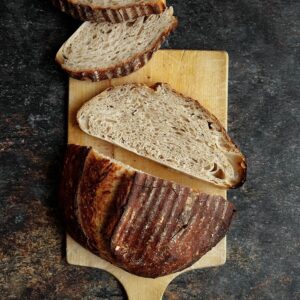
Rustic Sourdough Bread Recipe
This rustic sourdough bread is made using a combination of wheat and rye flour for a unique flavor and texture. The rye flour adds a nutty taste and contributes to a slightly more compact and even crumb structure, while the bread flour adds lightness. Together, they create a well rounded bread, ideal for sandwiches or just toasted with a bit of butter and jam.
Equipment
- bench scraper
- Banneton
Ingredients
For the leaven:
- 30 g sourdough starter
- 30 g water - lukewarm at around 30° C
- 60 g flour - bread flour or all-purpose
For the main dough:
- 90 g leaven - bubbly, active and doubled in size
- 420 g water - lukewarm
- 375 g bread flour
- 125 g light rye flour
- 11 g salt
Instructions
- To make the leaven, dissolve the sourdough starter in the water and add the flour. Mix until well combined. Let it rise in a warm spot for about 4 – 6 hours until bubbly, active and doubled in size.
- In a mixing bowl, mix the active leaven with the water until the liquid turns milky, and the leaven is almost fully dissolved. Add the flours and mix until a shaggy dough forms. Cover the bowl and let it rest on the counter for about 30 minutes. Add the salt and knead it in with wet hands (rye dough tends to be sticky, so make sure to wet your hands before handling the dough). For the bulk fermentation, transfer the dough to a lightly oiled proofing container and let it rise in a warm spot (25 – 28° C) for about 4 – 6 hours. Temperature plays an important role in the fermentation process. The warmer it is, the faster the dough rises. By the end of the bulk fermentation, the dough should have increased in size by about 50 – 75%.
- Turn the dough out onto a floured work surface and pre-shape it into a loose, rounded shape. Let it rest on the counter for 15 – 30 minutes. Flip it over with the seam-side facing up and shape it into a batard. Put the dough into a floured proofing basket, cover it and let it proof in the fridge overnight.
- The next morning, pre-heat the oven to 230° C. Turn the dough out of the banneton onto a piece of parchment paper. Using a bread lame or razor blade, score the surface of the dough lengthwise with one long stroke. This promotes good oven spring and allows the dough to rise and expand in the oven. Bake the bread with steam for the first 15 minutes (e.g. in a Dutch oven or with a tray filled with hot water on the bottom rack). Then, lower the temperature to 210° C, release the steam (take the lid off the Dutch oven or remove the steam tray) and bake for another 15-20 minutes until the crust is browned to your liking and the bottom of the bread sounds hollow when tapped. You can also use a thermometer to check for doneness. In this case, make sure the internal temperature reaches about 93° – 95° C. Let the bread cool completely on a wire rack before slicing.
Nutrition
Calories: 1872kcalCarbohydrates: 383gProtein: 61gFat: 8gSaturated Fat: 1gPolyunsaturated Fat: 4gMonounsaturated Fat: 1gSodium: 4296mgPotassium: 843mgFiber: 24gSugar: 3gVitamin A: 8IUCalcium: 101mgIron: 7mg